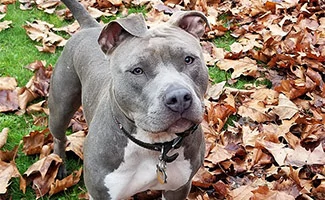Dangerous Dogs Act: What Breeds Are Covered?
When you purchase through links on our site, we may earn a commission. Here’s how it works.

The Dangerous Dogs Act is a law passed in the United Kingdom in 1991. It’s aimed to reduce the number of dog attacks by specific breeds. Parliament created the Act after several incidents that resulted in injury or death from particular breeds. This legislative response intends to protect the people.
Table of Contents
However, many have come to see this Parliamentary Act as being discriminatory and ineffective. Let’s discuss some of the specifics regarding the Dangerous Dogs Act. We’ll also look at whether or not this was an effective response to a societal concern in the UK.
What Is The Dangerous Dogs Act?

According to the 1991 Dangerous Dog Act passed by the United Kingdom parliament, it is illegal to own any “specially controlled dogs” without an exemption issued by the courts. Dogs within this specific categorization must also be:
- Muzzled
- Kept on a leash at all times when in public
- Registered and insured by their owners
- Neutered or spayed to prevent them from breeding
- Tattooed and microchipped
It also states that there shall be no breeding, no sale, or exchange of these dogs (even if one is exempt by the court). In 2014 the law extended beyond the public domain to include private property.
If caught with one of these dogs in public, they can be taken away on the spot. If police see a dangerous dog breed on private property, they must get a warrant to take your dog. It’s perfectly legal if the dog is on the exempt list (more on that below).
Which Dog Breeds Are Included In The Dangerous Dogs List?

According to the United Kingdom Dangerous Dogs Act, four specific types of dogs are considered dangerous dog breeds. Dog breeds that are illegal in the UK include:
- Dogo Argentino
- Fila Brasileiro
- Japanese Tosa
- Pit Bull Terrier
In addition, this act also includes dogs that appear to be a cross of these breeds. Unfortunately for many dogs, this results in persecution based on physical appearance.
The Dangerous Dogs Act has criticism for discriminating against a dog’s “breed label” rather than their behavior. The United Kingdom courts system determines if a dog meets the definition of a “dangerous dog.”
Why These Dog Breeds Or Mixes?
By nature, these dogs possess powerful jaws with the ability to cause incredible amounts of damage due to the pressure per square inch. However, none of these breeds even fall in the top five for having the strongest bite.
What Is The Index Of Exempted Dogs?
There are cases where dogs under the specific controlled dogs’ list can be exempt from the act. A list of these dogs referred to as the “Index of Exempted Dogs” is maintained by the Animal Welfare Section of the Department for Environment, Food and Rural Affairs in the U.K. This group is responsible for registering all specially controlled dogs residing within England and Wales.
The list of exempted dogs was closed to new additions between 1992 and 1997. However, in late 1997 an amendment to the Dangerous Dogs Act reopened the list to allow courts to add specific dogs to the index. Owning one of these banned breeds or cross breed dogs that are not on the index of exempted dogs is considered illegal.
Is The Dangerous Dogs Act Only Enforced In The United Kingdom?

The term “Dangerous Dogs Act” refers specifically to the 1991 law passed by the Parliament of the United Kingdom, and the 1997 amendment allowed them to add dogs to the list of exemptions again.
While the Dangerous Dog Act applies in the United Kingdom, many other countries and local municipalities have adopted their versions of the legislation. Not all of these acts and laws are equal in tackling the “problem.”
In some Australian locales, “dangerous” dogs must wear a red collar with yellow stripes. In particular areas of Queensland, Australia, these dogs can be seized and destroyed based on their label.
Breed Specific Legislation in the U.S.
In the late 1980s, city and county governments started passing Breed Specific Legislation (or BSL). These local laws can ban specific breeds or have their owners adhere to particular rules like muzzling or insurance. Critics of BSL have tried to overturn the ordinances. However, state courts have deemed them legal. For example, Denver banned Pit Bulls in 1989, despite Colorado amending the law in 2004. In 2020, the city of Denver overturned the BSL with an overwhelming 65% of voters’ support.
Dangerous Dog Breed List In The U.S.
The label “dangerous dog” now includes several other breeds and crossbreeds. The United States has also added “Dangerous Breed Lists” to many Homeowners Insurance policies. So, take a close look at your insurance policy’s dog breeds blocklist. Here’s a list of common dogs considered dangerous in the U.S. (which varies by location).

- Argentine Dogo
- Bedlington Terrier
- Boston Terrier
- Bull Terrier
- Bully Kutta
- Cane Corso
- Dogo Sardesco
- Dogue de Bordeaux
- English Mastiff
- Gull Dong
- Irish Staffordshire Bull Terrier
- Korean Jindo Dog
- Lottatore Brindisino
- Neapolitan Mastiff
- Perro de Presa Canario
- Perro de Presa Mallorquin
- Shar Pei
Some of these breeds seem to conform to the “dangerous breeds” definition outlined by the United Kingdom Parliament. However, many dangerous dog insurance lists bear no resemblance to the original Dangerous Dogs Act’s four “dangerous” dog breeds.
Watch this video exploring the most dangerous dog breeds and debunking a few myths.
What Does This Mean For Owners Of “Dangerous” Breeds?
If you currently have one of these “dangerous” dog breeds or a BSL in your area, this could mean various things, depending on where you live. Several states make exceptions for dogs living in the designated area for a particular amount of time – namely dogs that had existed in the local area for years before the dangerous dog law started.
In most states, owning any of the “dangerous” dog breeds or breed crosses that have already shown incidences of aggression is a free pass for regulating organizations to confiscate and destroy your dog.
In most cases, these types of dogs have not shown aggressive behavior. So, these rules add many hoops to jump through to keep or get a beloved family pet. Simply having a clean record for a dog classified as “dangerous” is not enough to protect it from confiscation under most circumstances.

These owners must conform to regulatory rules by carrying dog liability insurance if an incidence of aggression arises. They must also neuter or spay their dog to prevent further growth of the “dangerous dog” population.
For those individuals who live in apartments or plan to move to one, the rules are much harder to conform to to “maintain safer” communities. Most apartment complexes within the United States entirely ban ownership of these “dangerous dog” types and will refuse to rent to anyone who owns one of these prohibited dogs.
How To Protect Yourself And Your Dog If You Have A “Dangerous Dog” In The United States
The best way to understand your options if you live in the U.S. is to reach out to an insurance company specializing in dog liability insurance. That way, you have protection from losing your homeowners insurance.
Is The Dangerous Dogs Act (And BSL) Effective?

According to many credible sources in the United Kingdom, the Dangerous Dogs Act has not worked well in protecting people from dog attacks. Several aggressive dog types do not fall within the physical description of any of the breeds recognized by the act.
Because “dangerous dogs” can inflict a considerable amount of damage does not mean that all dogs with the same characteristics will harm. Likewise, many other breeds not considered “dangerous” can attack others. Since the law went into effect in 1991, only 9 of the 52 dog fatalities in the U.K. were from dogs not on the dangerous list.
There are also concerns over compliance with the Dangerous Dogs Act. Those most likely to comply are most likely to own well-trained, vaccinated dogs.
The individuals who breed dangerous breed dogs take part in dog fighting rings and other such disgraceful activities. These individuals give those breeds a terrible reputation. Because law requires these dogs to register does not mean that they are. The most aggressive dogs are often unregistered, so the “Dangerous Dogs Act” appears to have failed.
Why Is There So Much Controversy Over It?

Much of the controversy over the Dangerous Dogs Act and Breed Specific Legislation comes from the aforementioned subject. Simply because a dog is a specific breed does not mean it will be aggressive. All dogs can inflict significant amounts of damage on a human being if they choose. But according to many, it is the breeding and upbringing of the dog that results in a dangerous dog.
Indeed, all dogs of certain breeds have physical similarities. All pit bulls possess jaw strength. But asserting that all dogs with this physical characteristic will attack or kill an individual is unfair. It is like saying that a human with a muscular build will attack others.
It is difficult to determine the level of “dangerous” based on statistics. The complexity of this subject is twofold. The first concern is the accuracy of dog breed determination. A non-trained professional (like a police officer filing a report) can easily misidentify a dog breed, unlike a dog breed professional.
A dog expert can tell the breed of most dogs right away. However, a non-professional most likely will be unable to identify a dog’s breed accurately is inaccurate. Dogs that bite mean they are aggressive because of their behavior rather than considering their genetic makeup.

An excellent example of this is the Golden Retriever, a popular dog for families with children where insignificant biting incidents happen.
Comparing a beloved family golden retriever who bites a child but releases and leaves only a tiny puncture wound to a dog like a pit bull with a much stronger bite and may not let go is problematic when considering the damage done by a single bite.
When less fatal bites go unreported, they skew the data and lead families to believe that the “dangerous” dog breeds are most likely to bite.
What Does It All Mean?
Discussing breed-specific dog laws can be confusing because, frequently, emotions run high, and everyone wants to have their point of view heard. The fact remains that as it currently stands, the Dangerous Dogs Act is not proving to be very useful, and the skewed statistics. Unfortunately for dogs within the “dangerous dogs” classification, fewer people are willing to offer these dogs a chance at everyday life.



